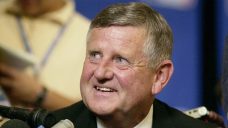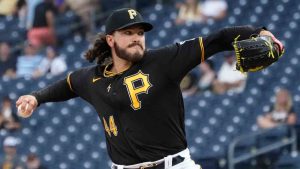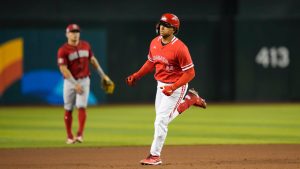The Blue Jays finally added a meaningful offensive piece to their lineup Tuesday, reportedly agreeing to a $13-million, one-year deal with Justin Turner.
The 39-year-old’s riding a decade-long streak as an above-average hitter and coming off a season that saw him OPS .800 while drawing walks at a steady clip and striking out in only 17.6 per cent of his plate appearances, which ranked within the top quarter of the league. This may say more about the 2023 Blue Jays than it does about Turner, but last year he hit more homers (23) than any Toronto hitter not named Vladimir and posted a higher contact rate (84.3 per cent) than any not named Alejandro.
Of course, when talking about an athlete who will turn 40 in November, one must be cautious in projecting that production forward. Turner’s been defying the aging curve in terms of both durability and productivity for years. Only four players in their age-39 season or older made more than 150 plate appearances last year — none of them more than Miguel Cabrera’s 370 on a retirement tour. And none OPS’ed better than Joey Votto’s .747.
So, expectations must be measured. Over at FanGraphs, ZiPS remains bullish on Turner in his 16th big-league season, projecting him to hit .282/.356/.438 with a slight power drop-off but a still quite respectable 115 wRC+. Steamer, meanwhile, is considerably more cautious, forecasting Turner as a .261/.333/.414 hitter in 2024 with a 105 wRC+.
A reasonable expectation probably lies somewhere in the middle of those two projections. The Blue Jays don’t need Turner to carry their offence. But they will look to him to help replace some of the walks and extra-base hits lost with the departures of Matt Chapman and Brandon Belt.
Turner proved last season he can still manage the strike zone well, run a near-elite contact rate, and get the true part of his barrel — he posted a 71st percentile sweet spot rate — to the ball consistently. But there are cautionary indicators in his profile, as well. Turner’s production against right-handed pitching has been sliding since 2022; he just posted the lowest barrel rate of his career; and he had a tough time with four-seam fastballs last season, earning a -7 run value against the pitch he’s thrown most often.
Considering the price the Blue Jays are paying, they clearly believe Turner has another season of above-average production in him. And it was only a year ago that this front office made a great bet on a veteran with plenty of question marks in Belt. There’s value in Turner’s leadership abilities, too, as he adds a respected, battle-tested presence to Toronto’s environment. This obviously isn’t the super high-impact addition the Blue Jays began this off-season envisioning. But it makes them better, which is what these final weeks of winter are about.
•••
Even with Turner in the fold, there’s room for the Blue Jays to make another addition if the right fit is out there. As things stand today, here’s how Toronto’s big-league position player group looks:
C: Danny Jansen
1B: Vladimir Guerrero Jr
2B: Cavan Biggio
SS: Bo Bichette
3B: Isiah Kiner-Falefa
LF: Daulton Varsho
CF: Kevin Kiermaier
RF: George Springer
DH: Justin Turner
-----
C: Alejandro Kirk
INF: Santiago Espinal
INF: Davis Schneider
OF: Nathan Lukes
You can make a case for Spencer Horwitz, Ernie Clement or Otto Lopez in that final bench spot, but the Blue Jays will likely want a trustworthy defensive outfielder there. Lukes is a fine player with strong triple-A numbers, but Toronto didn’t show much faith in him against big-league pitching last year. He spent 86 days on the active roster and received only 31 plate appearances. And a better fit would be an outfielder who capably hits left-handed pitching, as that would lessen the exposure Kiermaier and Varsho would see against lefties.
Who could fill that role? The likeliest answer may be whoever comes across waivers late in spring training or early in the season. This year’s Jordan Luplow. The club doesn’t seem to mind some fungibility in that spot and made use of all five of Lukes’ options last year. But if the Blue Jays want to aim a touch higher, there are a few options floating around.
Tommy Pham, Michael A. Taylor and Adam Duvall all make sense but will likely cost somewhere in the range of $6-9 million for 2024. Would the Blue Jays see the value in that outlay for a part-time player who may only get 300 plate appearances? Would those veterans be willing to accept a limited role or continue seeking a bigger one elsewhere? Remains to be seen.
Randal Grichuk’s crushed left-handed pitching the last two years but the Blue Jays didn’t show much interest in a reunion when he was repeatedly available last season. Robbie Grossman’s a monster against lefties but the defensive track record’s spotty. Still, they’d be fits and should cost less than the aforementioned trio.
Enrique Hernandez used to hit lefties but is coming off a couple miserable offensive seasons (how much of that is linked to playing through the issues that led to Hernandez undergoing double hernia surgery in October remains to be seen). AJ Pollock has an .836 career OPS vs. left-handed pitching but his 2023 was so woeful that he was released by the San Francisco Giants during a September wild-card race. It's tough to see the Blue Jays giving either of those two a big-league deal.
There will always be the option of waiting it out and seeing if anyone’s interested in coming to camp on a minor-league pact with a modest $1-2 million guarantee if they make the major-league team. If the player proves he still has something left in the tank, you can select their contract towards the end of spring training and round out your bench. If he doesn’t, you can see if they’ll start the year at triple-A or simply walk away.
There’s no doubt that veterans like Grichuk, Grossman, Hernandez, and Pollock, who were recently near-everyday players, will seek opportunities with clearer paths to regular playing time. But if one of them ends up on the outside looking in, the Blue Jays could be opportunistic and find a low-cost, low-risk way to upgrade their bench.
•••
Another thing to keep in mind as the Blue Jays round out their roster in the coming weeks: payroll and the second luxury tax threshold.
Toronto’s precise player personnel budget can be a bit of a moving target. It’s not quite as simple as the conventional structure most envision, in which a team spends up to a fixed maximum number. Toronto’s front office can bring various proposals to ownership — Rogers Communications, which also owns Sportsnet — as circumstances develop and scenarios arise throughout the off-season, which makes the final payroll figure more dynamic.
That’s one of the reasons why you hear the Blue Jays mentioned in the markets of so many players throughout the winter. The club doesn’t cut itself off from any opportunities and, if it can make a sound business and competitive case to ownership for a signing or trade, has latitude to pursue high-impact additions on a case-by-case basis. Think Freddie Freeman, Corey Seager, and Shohei Ohtani.
Now, when asked about Toronto’s 2024 spending at the off-season’s onset, Blue Jays President Mark Shapiro said, “I don’t expect a dramatic philosophical shift in payroll next year — I expect us to stay in the same area.” What’s that area? Well, the club’s 2023 competitive balance tax payroll — which includes a bunch of ancillary costs such as player benefits and payment into MLB’s pre-arbitration bonus pool — came in at roughly $246-million, per Roster Resource. So, that’s a decent starting point for 2024 expectations.
But even allowing for a modest year-over-year bump beyond $250-million, it stands to reason that the Blue Jays — positioned to be a CBT payor for a second consecutive season, meaning they’ll be taxed 30 per cent on every dollar spent above $237-million — would prefer to stay below MLB’s second luxury tax threshold of $257-million. Any spending above that threshold would incur an additional 12 per cent surcharge. So, assuming Toronto’s CBT payroll could end up somewhere in the range of $250-257 million is a decent guess. At least the best we can make based on the information available.
Here's the thing — when including Turner’s $13-million deal, plus the reported $8-million average annual value of Yariel Rodriguez’s contract and assuming Guerrero wins his arbitration hearing at $19.9 million, the Blue Jays are already up to a CBT payroll estimate of around $250-million per Roster Resource (the club winning Guerrero’s arbitration hearing at their filing of $18.05 million would knock it down to around $248 million). If the Blue Jays want to remain below the second luxury tax threshold, they could have only $7-9 million remaining to work with.
Of course, teams can always find ways to create flexibility. Rodriguez’s deal could include deferrals. Someone like Espinal or Trevor Richards could be traded to free up a few million. Or the Blue Jays could simply spend past the second threshold if they deem it necessary. The club’s already positioned to run a franchise-record payroll in 2024 as it tries to capitalize on its current competitive window and draw large crowds to a freshly renovated Rogers Centre. If you’re getting wet, might as well go swimming.
The good news is the Blue Jays aren’t limited by payroll in what they can still accomplish ahead of opening day. And shouldn’t be limited come the trade deadline, when it’s all but a guarantee the club will be looking to add talent. But that second luxury tax threshold is certainly something to keep in mind as it all plays out.
•••
If you’re an At the Letters listener, you’ve no doubt heard me say this on more than a few occasions: acquisition cost is very informative when framing expectations for a player.
When the Blue Jays traded their Nos. 1 and 4 prospects per Baseball America — Austin Martin and Simeon Woods Richardson — for Jose Berrios when he was less than a year-and-a-half from free agency, it strongly suggested the club was confident it would be able to extend him beyond that time frame. Turns out they were (and the industry was way too high on Martin, which is another story altogether).
When the Blue Jays dealt a relief prospect — right-hander Matt Svanson — for Paul DeJong and cash at last year’s trade deadline, it strongly suggested the club didn’t expect much from the 30-year-old veteran as an emergency fill-in for an injured Bo Bichette. “Relief prospect” is arguably an oxymoron. Particularly when that relief prospect is a 24-year-old pitching at high-A. And the St. Louis Cardinals even included money to cover part of DeJong’s salary and his buyout. DeJong went 3-for-44 with the Blue Jays and was released less than three weeks after he was acquired.
So, it’s worth considering the reported acquisition cost — $32-million over four years — of Rodriguez, the Cuban right-hander who will be a fascinating project to follow over the next several seasons. That works out to an $8-million AAV or on the low end of the going rate for a right-handed set-up reliever on the open market:
2024 right-handed set-up reliever free agent signings
David Robertson — 1 year, $11.5-million ($11.5-million AAV)
Robert Stephenson — 3 years, $33-million ($11-million AAV)
Reynaldo Lopez — 3 years, $30-million ($10-million AAV)
Hector Neris — 1 year, $9-million ($9-million AAV)
Joe Jimenez — 3 years, $26-million ($8.67-million AAV)
Emilio Pagan — 2 years, $16-million ($8-million AAV)
Joe Kelly — 1 year, $8-million ($8-million AAV)
Pierce Johnson — 2-years, $14.25-million ($7.13-million AAV)
One reason acquisition cost can tell you so much about a player — particularly one with as many unknowns as Rodriguez — is that most MLB clubs have become extremely adept and likeminded in valuing players. Look how similar all those free agent leverage reliever deals ended up being on an annual basis. With only odd exceptions — a team near the foot of the Rocky Mountains comes to mind — clubs don’t stray far from these established market values.
And the Blue Jays in particular are not in the business of offering contracts or agreeing to trade proposals they don’t believe they’ll reap value on. That tells you Toronto believes Rodriguez is capable of being a lower-end leverage reliever at a minimum. That tracks if you’re applying a slight handicap to what Rodriguez was during his last NPB season in 2022, when he pitched to a 1.15 ERA with a 27.5-per=cent strikeout rate over 56 outings in a set-up role with the Chunichi Dragons.
Rodriguez’s fastball has played up to the high 90’s out of the bullpen, which, paired with his mid-80’s, high-spin slider, gives him two plus weapons to attack hitters with during max-effort, single-inning stints. Story checks out. His floor could be akin to how the Blue Jays have used Yimi Garcia.
His ceiling? Who knows. The Blue Jays will start stretching him out this season and see what he’s capable of. If they can develop Rodriguez into a five-and-dive starter who backfills for Yusei Kikuchi in 2025, or even a one-trip-through bridge guy like Michael King was for the Yankees before he joined their rotation late last season, they ought to be well into surplus value on the salary they’re paying him. Compare his $8-million to the going rate for back-end starters and swingman types this winter:
2024 back-end starter free agent signings
Jack Flaherty — 1 year, $14-million ($14-million AAV)
Sean Manaea — 2 years, $28-million ($14-million AAV)
Kyle Gibson — 1 year, $13-million ($13-million AAV)
Nick Martinez — 2 years, $26-million ($13-million AAV)
Kenta Maeda — 2 years, $24-million ($12-million AAV)
James Paxton — 1 year, $11-million ($11-million AAV)
Lance Lynn — 1 year, $11-million ($11-million AAV)
There’s another tight value band. Now, the difference between Rodriguez and all the free-agent deals cited is he’s getting more term. Four years of it. There’s risk in that for the Blue Jays. But they’re no doubt comfortable with it considering Rodriguez has yet to turn 27, while all the pitchers in both categories above — save for the 29-year-old Jimenez — are well into their 30’s. The Blue Jays are signing up for what ought to be Rodriguez’s prime. And they’re getting him coming off a year of rest while awaiting international free agency.
Toronto’s bet is it can help Rodriguez develop a consistent third pitch he can use against left-handers, throw strikes more consistently, and maintain his stuff across multiple innings. That’s no easy feat. It didn’t work out for Rodriguez when he was last tried as a starter earlier in his NPB career. But the Blue Jays track record of getting the most out of at-times erratic pitchers with intriguing raw stuff — Kikuchi, Robbie Ray, Steven Matz — has some success stories. And Rodriguez has already shown room for development, gaining velocity over his years in Japan.
Maybe it works out, maybe it doesn’t. Even if Rodriguez proves untenable as a starter, the set-up reliever fall-back plan should remain a card the club could play. And maybe they play it even if things are going well.
Each of the last two Octobers, the Blue Jays have tried to use Kikuchi as a reliever in the post-season. Results have, uh, been mixed. But Rodriguez has already-established reliever routines from his time in Japan, and even if he’s pitching longer outings during the regular season, he ought to be able to more easily transition to a leverage relief role come the playoffs than another starter who isn’t accustomed to the adjustment.
Which ties back to the value. Regardless of what role(s) his fills or how his development as a starter progresses this year, the Blue Jays are paying Rodriguez like a pitcher they expect to be getting high leverage outs for them in the post-season. His MLB arc will be a fascinating one to watch. But don’t be surprised if, come October, he’s on the mound in some big moments for his new club.
Arden Zwelling is an on-field reporter for Blue Jays broadcasts on Sportsnet. Gap to Gap is his regular space for expanded Blue Jays and MLB notes, thoughts, and non-sequiturs that don’t quite fit on TV.






